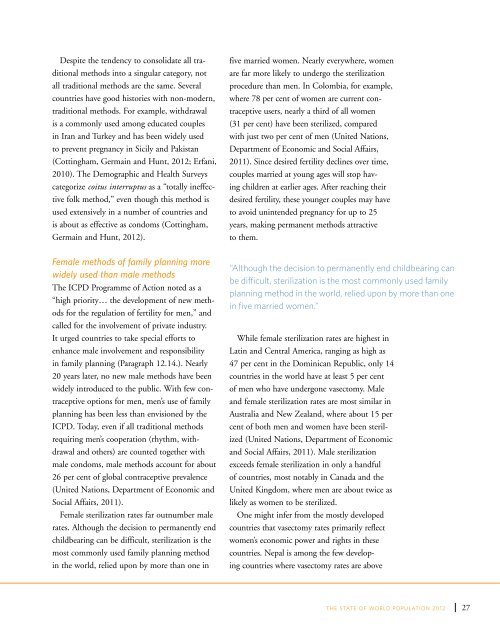State of World Population 2012 - Country Page List - UNFPA
State of World Population 2012 - Country Page List - UNFPA
State of World Population 2012 - Country Page List - UNFPA
You also want an ePaper? Increase the reach of your titles
YUMPU automatically turns print PDFs into web optimized ePapers that Google loves.
Despite the tendency to consolidate all traditional<br />
methods into a singular category, not<br />
all traditional methods are the same. Several<br />
countries have good histories with non-modern,<br />
traditional methods. For example, withdrawal<br />
is a commonly used among educated couples<br />
in Iran and Turkey and has been widely used<br />
to prevent pregnancy in Sicily and Pakistan<br />
(Cottingham, Germain and Hunt, <strong>2012</strong>; Erfani,<br />
2010). The Demographic and Health Surveys<br />
categorize coitus interruptus as a “totally ineffective<br />
folk method,” even though this method is<br />
used extensively in a number <strong>of</strong> countries and<br />
is about as effective as condoms (Cottingham,<br />
Germain and Hunt, <strong>2012</strong>).<br />
five married women. Nearly everywhere, women<br />
are far more likely to undergo the sterilization<br />
procedure than men. In Colombia, for example,<br />
where 78 per cent <strong>of</strong> women are current contraceptive<br />
users, nearly a third <strong>of</strong> all women<br />
(31 per cent) have been sterilized, compared<br />
with just two per cent <strong>of</strong> men (United Nations,<br />
Department <strong>of</strong> Economic and Social Affairs,<br />
2011). Since desired fertility declines over time,<br />
couples married at young ages will stop having<br />
children at earlier ages. After reaching their<br />
desired fertility, these younger couples may have<br />
to avoid unintended pregnancy for up to 25<br />
years, making permanent methods attractive<br />
to them.<br />
Female methods <strong>of</strong> family planning more<br />
widely used than male methods<br />
The ICPD Programme <strong>of</strong> Action noted as a<br />
“high priority… the development <strong>of</strong> new methods<br />
for the regulation <strong>of</strong> fertility for men,” and<br />
called for the involvement <strong>of</strong> private industry.<br />
It urged countries to take special efforts to<br />
enhance male involvement and responsibility<br />
in family planning (Paragraph 12.14.). Nearly<br />
20 years later, no new male methods have been<br />
widely introduced to the public. With few contraceptive<br />
options for men, men’s use <strong>of</strong> family<br />
planning has been less than envisioned by the<br />
ICPD. Today, even if all traditional methods<br />
requiring men’s cooperation (rhythm, withdrawal<br />
and others) are counted together with<br />
male condoms, male methods account for about<br />
26 per cent <strong>of</strong> global contraceptive prevalence<br />
(United Nations, Department <strong>of</strong> Economic and<br />
Social Affairs, 2011).<br />
Female sterilization rates far outnumber male<br />
rates. Although the decision to permanently end<br />
childbearing can be difficult, sterilization is the<br />
most commonly used family planning method<br />
in the world, relied upon by more than one in<br />
”Although the decision to permanently end childbearing can<br />
be difficult, sterilization is the most commonly used family<br />
planning method in the world, relied upon by more than one<br />
in five married women.”<br />
While female sterilization rates are highest in<br />
Latin and Central America, ranging as high as<br />
47 per cent in the Dominican Republic, only 14<br />
countries in the world have at least 5 per cent<br />
<strong>of</strong> men who have undergone vasectomy. Male<br />
and female sterilization rates are most similar in<br />
Australia and New Zealand, where about 15 per<br />
cent <strong>of</strong> both men and women have been sterilized<br />
(United Nations, Department <strong>of</strong> Economic<br />
and Social Affairs, 2011). Male sterilization<br />
exceeds female sterilization in only a handful<br />
<strong>of</strong> countries, most notably in Canada and the<br />
United Kingdom, where men are about twice as<br />
likely as women to be sterilized.<br />
One might infer from the mostly developed<br />
countries that vasectomy rates primarily reflect<br />
women’s economic power and rights in these<br />
countries. Nepal is among the few developing<br />
countries where vasectomy rates are above<br />
THE STATE OF WORLD POPULATION <strong>2012</strong><br />
27
















